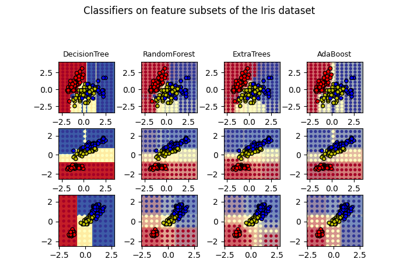Note
Go to the end to download the full example code. or to run this example in your browser via Binder
多输出决策树回归#
一个使用决策树进行多输出回归的示例。
使用 决策树 同时预测圆的噪声 x 和 y 观测值, 给定一个单一的潜在特征。结果是,它学习了近似圆的局部线性回归。
我们可以看到,如果树的最大深度(由 max_depth 参数控制)设置得太高,
决策树会学习训练数据的过细细节并从噪声中学习,即它们会过拟合。

import matplotlib.pyplot as plt
import numpy as np
from sklearn.tree import DecisionTreeRegressor
# 创建一个随机数据集
rng = np.random.RandomState(1)
X = np.sort(200 * rng.rand(100, 1) - 100, axis=0)
y = np.array([np.pi * np.sin(X).ravel(), np.pi * np.cos(X).ravel()]).T
y[::5, :] += 0.5 - rng.rand(20, 2)
# 拟合回归模型
regr_1 = DecisionTreeRegressor(max_depth=2)
regr_2 = DecisionTreeRegressor(max_depth=5)
regr_3 = DecisionTreeRegressor(max_depth=8)
regr_1.fit(X, y)
regr_2.fit(X, y)
regr_3.fit(X, y)
# Predict
X_test = np.arange(-100.0, 100.0, 0.01)[:, np.newaxis]
y_1 = regr_1.predict(X_test)
y_2 = regr_2.predict(X_test)
y_3 = regr_3.predict(X_test)
# 绘制结果
plt.figure()
s = 25
plt.scatter(y[:, 0], y[:, 1], c="navy", s=s, edgecolor="black", label="data")
plt.scatter(
y_1[:, 0],
y_1[:, 1],
c="cornflowerblue",
s=s,
edgecolor="black",
label="max_depth=2",
)
plt.scatter(y_2[:, 0], y_2[:, 1], c="red", s=s, edgecolor="black", label="max_depth=5")
plt.scatter(
y_3[:, 0], y_3[:, 1], c="orange", s=s, edgecolor="black", label="max_depth=8"
)
plt.xlim([-6, 6])
plt.ylim([-6, 6])
plt.xlabel("target 1")
plt.ylabel("target 2")
plt.title("Multi-output Decision Tree Regression")
plt.legend(loc="best")
plt.show()
Total running time of the script: (0 minutes 0.117 seconds)
Related examples





